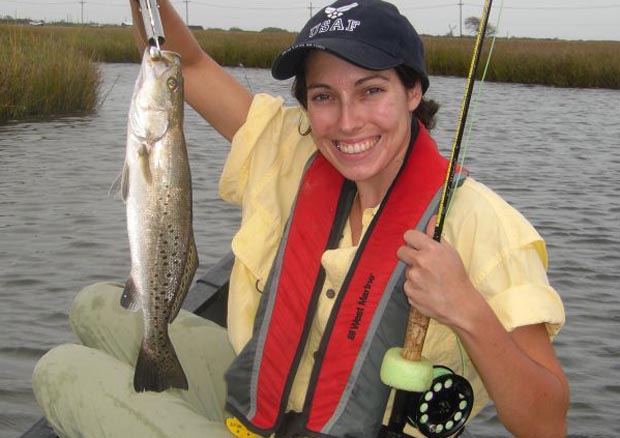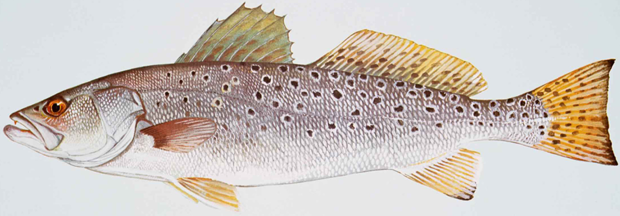A Father-Son Fishing Trip on the Chesapeake Bay
STAFF NOTE: Speckled trout (Cynoscion nebulosus) are also known as spotted seatrout. They’re not part of the trout family, but part of the croaker family and first cousin to the drum (redfish / black drum) family. World record IGFA All Tackle is 17-pounds 7-ounces (Fort Pierce, FL / May 1995). Fly record is 15-pounds 6-ounces on 16-pound test (Port Isabel, TX / May 2002).
By Tim Neville / NYT Sunday Travel Section
[dropcap]T[/dropcap]he breeze came slow and easy out of the west, and the creek was glassy and calm as if it were just waking up, too. From the wharf in Onancock, a hamlet on Virginia’s Eastern Shore, the Onancock Creek courses for about five miles past stately homes and black water coves to empty in the Chesapeake Bay. Out there the waves would be less than a foot high, perfect conditions for our prey. “Those specks really like clear water,” said Bob Walter, a 58-year-old fishing guide everyone calls Captain Walt. My father, Bill Neville, stood next to him near the skiff’s center console as we motored downstream, the wake fracturing the sunlight into golden tesserae. The captain had been doing this for 43 years, and my father, who is in his 70s, has pretty much spent his entire life within whiffing distance of the bay. For as long as I can remember he has been chasing speckled trout.
In the late summer, when the bay is the saltiest and warmest it will be all year, specks, or spotted sea trout as they’re formally known, become the talk of fishermen all along the 195-mile-long bay. The Chesapeake, North America’s largest estuary, marks the northern reaches of the fish’s range and speck numbers seem to peak in the hot, hazy days of August and early September. If you friend the right folks, your social media streams can spill their banks with pictures of people holding the fish with the fat flopped over their fingers.
To be sure, speckled trout are no marlins. Five pounds is big. Anglers in places like Port Eads, La., routinely catch specks that size and more of them, but the zeal for speckled trout fishing extends around the Gulf, up the Atlantic and into the Chesapeake, where abundant eelgrass beds and shallow flats make for ideal habitat. In such “skinny” water, speckled trout feel vulnerable and spook easily, which makes them tricky (and fun) to catch. Hook one and it will splash about and give a good fight, but it’s no Hemingway tale. These are the bay’s soft beauty queens with freckled backs and iridescent sides that glimmer like rainbows in your hands. They are at their best when grilled with a hint of lemon and paired with a side of turnip greens.
I grew up on the Chesapeake, on the Eastern Shore of Maryland, about an hour north of Onancock, but it was only last year, after living in Oregon for nearly a decade, that I became a fisherman, specifically, a fly fisherman. I can read for hours about bugs and knots and how to trick a fish with hair and hackle, but honestly, those are just the perks. The addiction comes from the places fly-fishing has opened to travel.
Patagonian trout, not the mountains, got me to Argentina. The chance to land a native cutthroat made Yellowstone National Park infinitely more interesting than its geysers. Crook County, Ore., can seem sedate. Then you stand knee deep in its cold Crooked River, fly rod wagging at the sun-fired walls of a basalt canyon, and suddenly it’s the only place you can think about.
I had never heard of anyone fly-fishing the Chesapeake, but that’s because I hadn’t asked around. When I did, I found guides — real fly-fishing guides — all around the bay willing to take me out. My map showed places, like Gloucester Courthouse and Onancock, that I’d never visited because I’d never really had a reason to. Fishing could change that.
Then one day my father phoned. “Boy,” he said in his natural “shore-billy” accent, “I’ve caught more speckold trout this summer than I have in my entahr life. It’s as good as I’ve ever seen it.”
I packed my rods and flew out.
The Germans have an expression that says, why make things simple when complicated also works. That’s fly-fishing in a nutshell.
The simple way to fish for specks is to spin-cast, whereby you attach a jiggly lure to a light fishing line, sling it out and reel it in. The lures, or flies, in fly-fishing are far too light to cast — how far can you throw a feather? — so instead you must cast the line, which is thicker and heavier than regular fishing line. The fly just tags along for the ride.
It is easier said than done. You don’t just cast a fly line but “false cast” it, “roll cast” it and “double haul” it, different techniques for different situations. Golfers have their clubs; fly fishers have their lines. Some sink, some float, some do a little of both, and the ways you retrieve your line depend on the fly, the line, the fish and a million other things that boil down to instinct and art. Get good at spin casting and it still feels mechanical. Master fly-fishing, though, and you become a wizard with a magical whipping wand that conjures creatures from the deep. I am no wizard, so I hired a guide.
Actually, three guides. I wanted to catch fish, yes, but I also wanted to explore the communities from which I might catch those fish. I wanted to eat fresh oysters at seaside sheds, run my fingers over tombstones from the American Revolution and sip lemonade on bayside patios. I picked three regions around the bay with established guides and that might be interesting culturally, too: one in the west and two in the east. Onancock came first.
Captain Walt throttled down in the open bay, where everything had a brilliant silvery haze about it. Just off the bow stood Watts Island, an uninhabited dollop of loblolly pines and wild asparagus. There used to be two islands here. Its neighbor, Little Watts Island, held a lighthouse, first built in 1833, until a storm in 1944 destroyed it and the bay reclaimed the land. Little Watts now is just a shoal, and all that remains of the lighthouse is a collection of submerged rock piles. Fish love structures like that.
“You don’t mind if I fish with you guys, do you?” the captain asked. We didn’t. He and my father rigged up spin-casting rods and hurled rubbery lures with wobbly tails into the water. I readied my own rod, a beginner Redington model, with a fast-sinking line.
Find out: Where to Fish I Top Guides I Best Accommodations I Great Restaurants > Read More . . .
[information]
The best how to book on seatrout was wriiten by Mike Holliday titled Secrets for Catching Seatrout
[/information]







